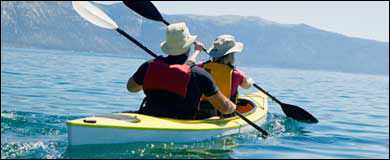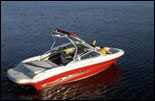Stay Safe on the Water: National Safe Boating Week 2010
 During National Safe Boating Week, May 22-28, 2010, and all year, "Wear It!" Everyone, on all types of boats, should wear properly-fitted life jackets, or personal flotation devices (PFD). By wearing a life jacket, you can dramatically decrease your chances of drowning in a boating incident.
During National Safe Boating Week, May 22-28, 2010, and all year, "Wear It!" Everyone, on all types of boats, should wear properly-fitted life jackets, or personal flotation devices (PFD). By wearing a life jacket, you can dramatically decrease your chances of drowning in a boating incident. During National Safe Boating Week, and all year, "Wear It!"
Everyone, on all types of boats, should wear properly-fitted life jackets, or personal flotation devices (PFD). By wearing a life jacket, you can dramatically decrease your chances of drowning in a boating incident.
Know the Facts
Recreational boating—enjoyed by over 70,000,000 Americans enjoy each year—can be a wonderful way to spend time with family and friends. And making boating safety a priority can ensure that it stays fun.
Consider that:
- In 2008, 3,330 people were injured, and more than 700 died, in boating incidents. Of those who drowned, 9 out of 10 were not wearing life jackets.
- More than 7out of every 10 (72%) of fatal boating incident victims drowned in 2008.
- Alcohol use was the leading contributing factor in fatal boating incidents.
Reduce Your Risk
Whenever you are headed out on the water, keep these tips from the U.S. Coast Guard in mind:
Wear it. Properly fitted life jackets can prevent drownings and should be worn by everyone on any boat, at all times. Coast Guard-approved life jackets are now better looking and more comfortable.
Don't Drink. Alcohol use affects judgment, vision, balance, and coordination. Reports suggest that alcohol was a contributing factor in about one in five boating fatalities.
Take a Course. People operating boats can help keep their passengers safe. Boating education courses teach the regulatory and statutory rules ("Rules of the Road") for safe operation and navigation of recreational boats.

Get a Vessel Safety Check. The Vessel Safety Check (VSC) is a free public service provided by the U.S. Coast Guard Auxiliary and U.S. Power Squadron volunteer organizations. For more information on the VSC Program, visit their web site: www.vesselsafetycheck.org.
Know about carbon monoxide (CO). All internal combustion engines, such as boat engines and onboard motor generators, emit CO, an odorless, colorless, poisonous gas. In the early stages, the symptoms of CO poisoning are similar to seasickness, but CO can kill in a matter of minutes. To avoid CO poisoning, be aware of the risk, ensure sufficient ventilation, properly install and maintain equipment, and use CO detectors, especially in living and sleeping areas. See "Prevent Carbon Monoxide Poisoning on Your Boat."
Also, be sure to check state and local requirements, available at the National Association of State Boating Law Administrators Web site.
More Information
Protect the Ones You Love

In an effort to raise parents' awareness about the leading causes of child injury in the United States and how they can be prevented, CDC has launched the "Protect the Ones You Love" initiative. Parents can play a life-saving role in protecting children from injuries. Learn more.
The following resources offer information that can help you stay safe on the water:
CDC Resources
- Facts and Resources about Water-related Injuries
- Protect the Ones You Love: Drownings Fact Sheet
- Healthy Swimming and Recreational Water Facts
- Download or listen to a podcast
Send an eCard
External Resources
- National Safe Boating Council
- North American Safe Boating Campaign
- U.S. Coast Guard Office of Boating Safety

External Resources
Get email updates
To receive email updates about this page, enter your email address:
Contact Us:
- Centers for Disease Control and Prevention
1600 Clifton Rd
Atlanta, GA 30333 - 800-CDC-INFO
(800-232-4636)
TTY: (888) 232-6348 - Contact CDC–INFO
 ShareCompartir
ShareCompartir





